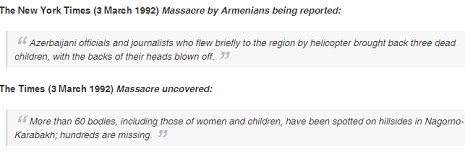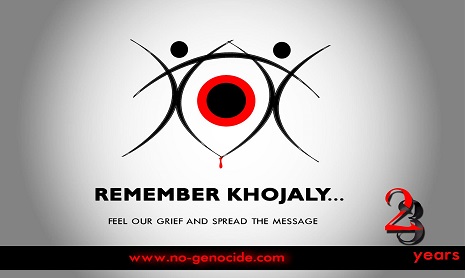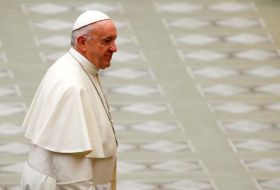During the decades of Soviet rule throughout the Caucasus, Armenia, with the help of Moscow, strategically and systematically expanded its territories into Azerbaijan – expelling thousands of Azerbaijanis in the process. In 1920, the Soviet Union falsely declared Armenian ownership of the Azerbaijani regions of Basarkechar and Vedibasar, together with parts of Zangezur. In 1923, the Nagorno-Karabakh region of Azerbaijan was given ‘autonomous status.’ On 20 February 1988, the Soviet of the People’s Deputies of the Nagorno-Karabakh Autonomous Region, with the support of Armenia, submitted a petition to the Supreme Soviets of the Azerbaijan SSR and Armenian SSR to transfer Nagorno- Karabakh from Azerbaijan to Armenia. Many regard this as the first step towards the conflict. It was discussed by the legislative body of the Azerbaijan SSR, and was rejected as being contrary to its constitution. The Armenians, however, continued to promote their claim. Following the dissolution of the Soviet Union in 1991, and with growing regional instability, armed conflict began in Nagorno-Karabakh.
The Khojaly Massacre
Khojaly was the second largest town in Nagorno-Karabakh, with a total area of 7.5km2, and was home to the only airport in the region. The Khojaly population before Armenia’s territorial claim was 23,757, but this had dwindled to 2,500 before that fateful February day. The situation in February 1992 was exceptionally bleak for Khojaly – there were no telecommunications, electricity, paraffin or water, and all food, other than locally-grown potatoes, ran out on 21 February. Escaping these dire conditions was not easy. The roads from Khojaly to surrounding Azerbaijan had been cut off, blockaded by Armenian forces and troops of the former USSR that were still in Nagorno-Karabakh, making helicopter access the only way to reach the town, and this attracted constant Armenian gunfire. The only other option for the Khojaly population was to flee the town on foot, which was an arduous, treacherous journey to safety. The inhabitants of Khojaly were at their most vulnerable on 26 February 1992[EP1].
On the eve of 25 February, Armenian armed forces began what they anticipated would be a final takeover of the area. Khojaly residents were told that if they evacuated they would be granted safe passage – they were soon to discover that this was a horrific act of deception. As the entire town’s population began to flee Khojaly, Armenian armed forces and members of the No. 366 Soviet motorised rifle regiment confronted them on the border. Armenian armed forces met the townspeople with fierce gunfire. The terrified and unarmed population, the majority of whom were woman and children, were slaughtered.
During the massacre, Armenian armed forces murdered 613 innocent Azerbaijanis, including 106 women, 63 children, and 70 elderly people. Of these deaths, 487, including 76 young children, had horrific injuries and 56 were killed by methods classified as ‘severe cruelty.’ Civilians were shot at close range, scalped and burned alive. Some had their eyes gouged out and others were beheaded. One pregnant woman was even bayoneted in the abdomen. Those wounded inhabitants who escaped the gunfire were forced to trek through the mountains to safety – many perished in the cold. A further 1275 people were taken hostage.
Once all the Khojaly citizens had been slaughtered, imprisoned, or had fled the town, Armenian soldiers quickly took control of the region with the partial objective of obscuring the scale of the massacre. Azerbaijani helicopters attempted to pick up the bodies, but continually came under fire. Most of the dead were carried in vehicles, being transported by the truckload. However, the whereabouts of a further 150 victims remain unknown. The massacre at Khojaly by Armenia contravened international law and violated Geneva conventions and articles 2, 3, 5, 9, and 17 of the Declaration of Human Rights (adopted by the UN General Assembly on 10 December 1948).
Armenia`s Story
As news of the massacre began to spread, Armenia reacted defensively. Its government fabricated inaccurate accounts of the tragic events that took place in Khojaly. One statement claimed that the massacre was nothing more than the result of a standard military operation, stating that civilian casualties were attributable to Azerbaijani troops defending their territory. Contrary to this claim, the statistics proved that the majority of retreating inhabitants were civilians, mostly women and children. Armenia also claimed that the Azerbaijani Popular Front massacred 100 Azerbaijani and Armenian civilians, positioning the dead bodies in order to apportion blame to the Armenians. Another Armenian claim was that media footage of disfigured Azerbaijanis was actually faked.
The Media`s Response
A report in Time magazine responded to Armenia’s claims, stating: “The facile explanation offered by the attacking Armenians, who insist that no innocents were deliberately killed, is hardly convincing.” Human Rights Watch found Armenia’s explanations overwhelmingly ‘unconvincing’ and Memorial, the Moscow-based human rights group, stated that: “The mass killing of civilians in Khojaly could not be justified under any circumstances, and the actions of Armenian militants were in gross violation of several basic international human rights conventions.”
Other major media outlets described the story in a similar horrified manner:


Ineffectual Response of the International Community
Despite a flurry of international news coverage immediately following the massacre, western media outlets quickly turned their attention to the other major conflict zones of the era, such as the Balkans and Rwanda. As a result, the vast majority of the world’s population knows nothing about Khojaly or the ongoing Armenian–Azerbaijani Nagorno-Karabakh conflict.
Western politicians and world leaders were slow to condemn this horrific event, and the world stood by as the mastermind of this massacre, former Defence Minister, Serzh Sargsyan, became President of Armenia. This man was quoted in the book Black Garden by Thomas de Waal, as stating: “Before Khojaly, the Azerbaijanis thought that...the Armenians were people who could not raise their hands against the civilian population. We were able to break that [stereotype].”
Western governments and media outlets may turn a blind eye to Khojaly, due to the Armenian lobby in the West, which exercises disproportionate influence because of the extensive Armenian diaspora. Others may be influenced by claims regarding the alleged ‘Armenian genocide’ in 1915. Neither of these influences can justify the abhorrent, horrific acts of 26 February 1992 and Armenia’s continued flouting of international law.
More about:
















































